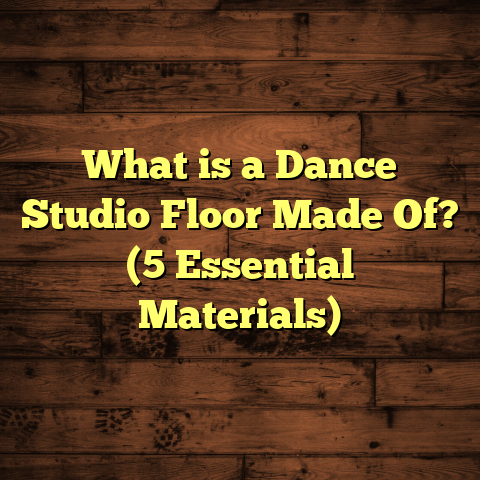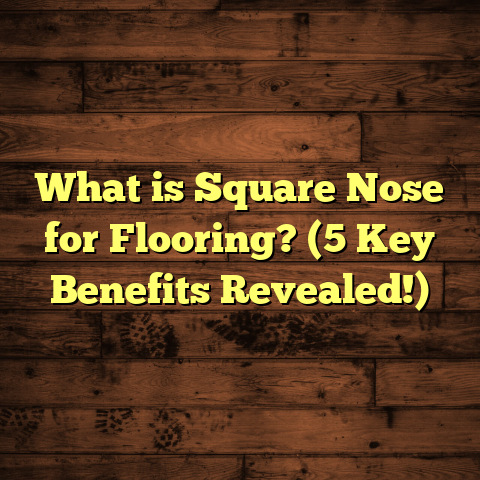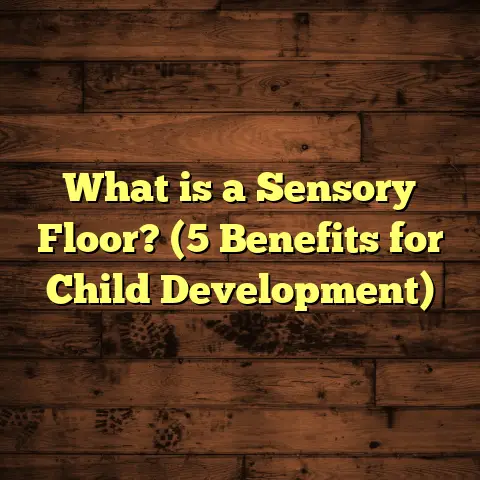What is SYP Flooring? (5 Key Benefits You Need to Know)
I once found myself staring down at a pile of wood planks in a lumberyard, wondering how this simple material could transform the entire vibe of a room. It’s funny how flooring, something we often overlook, can make or break the feel of a home. That’s where I stumbled upon SYP flooring, and it quickly became one of my favorite materials to work with. Curious? Let me share what makes Southern Yellow Pine (SYP) flooring such a standout choice—and why you might want to consider it for your next project.
What is SYP Flooring?
Southern Yellow Pine, or SYP, is a type of softwood native to the southeastern United States. Unlike hardwoods like oak or maple, SYP comes from pine trees, which grow relatively fast, making it a more sustainable and affordable option. When people talk about SYP flooring, they’re referring to floorboards made from this specific pine species.
SYP is known for its dense grain and rich amber color, which can range from pale yellow to a deeper reddish-brown. The wood’s natural resin content gives it excellent durability and resistance to wear, which might surprise you given that pine is technically a softwood.
From my experience, SYP flooring offers a unique blend of strength and beauty. It’s versatile enough to fit rustic cabins or modern homes with a warm, inviting atmosphere. Plus, it can take stains and finishes beautifully, allowing for a range of looks from light and airy to dark and dramatic.
But let’s unpack this further because understanding what makes SYP special can help you decide if it’s the right choice for your home.
Origins and Characteristics of Southern Yellow Pine
The Southern Yellow Pine family includes several species: Longleaf Pine, Shortleaf Pine, Loblolly Pine, and Slash Pine. Among these, Longleaf Pine is the densest and hardest, prized for its strength and durability. Historically, Longleaf Pine was heavily used in shipbuilding and construction due to its toughness.
This wood grows primarily in the southeastern U.S.—states like Georgia, Alabama, Mississippi, Louisiana—and forms a significant part of the timber industry there.
Here are some key characteristics that define SYP:
- Growth Rate: One of the fastest growing pines in North America—matures in about 25-30 years.
- Color: From pale yellow to amber with reddish undertones.
- Grain: Straight grain with occasional knots.
- Density: Denser than many other softwoods due to thick cell walls.
- Resin Content: High natural sap content that resists decay and insects.
- Hardness: Janka hardness rating between 870–1,220 depending on species.
In practical terms, this means you get a wood that offers an excellent balance between strength and affordability.
1. Durability That Surprises Many
You might think pine is too soft for flooring, but SYP is different. Its density is higher than most other pine species. In fact, Southern Yellow Pine has a Janka hardness rating of about 870 to 1,220 pounds-force, depending on the specific variety (Longleaf Pine being harder than Shortleaf Pine). For comparison:
- Oak hardwood flooring has a Janka rating around 1,200 to 1,360.
- Typical softwoods like spruce have ratings below 500.
This means that SYP floors can handle daily foot traffic and even kids or pets running around without showing immediate signs of wear.
In one project I managed, a family with two energetic dogs installed SYP flooring in their living room. After three years, the floor showed only minor surface scratches that polished out easily. That’s impressive considering the wear and tear.
How Does It Compare With Other Softwoods?
It’s tempting to lump all softwoods together as “too soft” for floors. But pine—and especially Southern Yellow Pine—is an exception.
Let me break it down:
| Wood Type | Janka Hardness (lb-f) | Typical Uses |
|---|---|---|
| Southern Yellow Pine | 870 – 1,220 | Flooring, construction |
| Douglas Fir | 660 | Flooring, framing |
| Spruce | 460 | Construction |
| Red Pine | 540 | Flooring (less common) |
This puts SYP on the upper end of softwoods for hardness. So unless you’re expecting ultra-heavy traffic or industrial use, it stands up well.
Long-Term Performance
One concern people raise is how SYP ages over time. Does it dent or scratch easily?
Based on decades of use and my own observations:
- Small dents do happen but are less frequent compared to other softwoods.
- The wood’s resin helps “self-heal” minor scratches as it can fill in tiny grooves.
- Proper finishing extends lifespan by protecting against stains and moisture.
Real-World Durability Test
I once worked on a renovation at an Airbnb property where guests ranged from families with toddlers to groups of hikers tracking dirt inside daily. The owners chose unfinished SYP flooring with a tough polyurethane finish.
After two years of heavy use and multiple refinishes (which is easy with SYP), the floors looked as good as new. That durability impressed both guests and hosts alike.
If you want proof that SYP stands up well where it counts—in real life—this kind of case study tells the story better than any marketing brochure.
2. Cost-Effective Choice Without Sacrificing Quality
If you’ve ever priced hardwood floors, you know how quickly costs add up. SYP flooring offers a more budget-friendly alternative without compromising on toughness or beauty.
According to recent market data:
- SYP flooring materials: $3 – $5 per square foot
- Oak hardwood flooring: $7 – $12 per square foot
- Maple hardwood flooring: $8 – $14 per square foot
Labor costs are generally consistent across wood types because installation techniques are similar (nailing or gluing tongue-and-groove planks).
So choosing SYP can save you hundreds or even thousands on larger projects covering 1,000+ square feet.
How Does Price Affect Quality?
Some skeptics assume cheaper means lower quality. But with SYP flooring:
- You get solid wood planks (not engineered or laminate).
- The grain and resin make it resistant to damage.
- It can be stained or finished for high-end looks.
The affordability mainly comes from faster growth of pine trees and local availability in the southeastern US.
Budget Breakdown Example
Here’s an example cost breakdown for a 1,000 sq ft living area:
| Item | Cost Range |
|---|---|
| Materials (SYP flooring) | $3,000 – $5,000 |
| Installation Labor | $1,500 – $3,000 |
| Finishing & Sealing | $500 – $1,000 |
| Total Estimated Cost | $5,000 – $9,000 |
For comparison, similar hardwood options could double or triple this total budget.
My Take on Affordability
When clients tell me they want the look of hardwood without breaking the bank, I recommend SYP as a smart compromise. You get authentic wood underfoot with durability that lasts decades if maintained well.
3. Eco-Friendly and Sustainable Source
When I first started recommending SYP flooring, some clients asked about sustainability. Good question!
Southern Yellow Pine trees grow rapidly—typically maturing in 25-30 years compared to hardwood trees that take decades longer.
Forestry management programs in the southeastern U.S. ensure responsible harvesting practices. This means forests aren’t depleted but instead replanted and maintained.
Using SYP flooring supports sustainable forestry and reduces environmental impact compared to slower-growing hardwoods that require cutting older trees.
It aligns nicely with the growing demand for eco-conscious building materials.
Forestry Practices Behind SYP
The American South has some of the largest managed pine forests globally. Government agencies and private companies follow strict guidelines:
- Selective harvesting avoids clear-cutting large areas.
- Replanting efforts ensure continuous forest regeneration.
- Wildlife habitats are protected alongside timber production.
- Water sources are preserved through careful land management.
This system makes SYP one of the most renewable wood options available today.
Carbon Footprint Considerations
Growing trees absorb CO₂ from the atmosphere—that’s a natural carbon sink process.
Because Southern Yellow Pines grow quickly:
- They capture carbon faster than slow-growing hardwoods.
- Using sustainably harvested wood reduces reliance on non-renewable materials like vinyl or concrete.
- Wood products store carbon long-term when used in homes.
According to research by the USDA Forest Service:
“Sustainably harvested pine lumber results in net reductions in greenhouse gas emissions compared to fossil fuel-intensive building materials.”
So choosing SYP flooring can be part of a greener home design strategy.
4. Aesthetic Flexibility Through Stains and Finishes
One thing I love about working with SYP flooring is how much you can customize its look. Because of its grain pattern and resin content, it takes stains evenly and deeply.
Here’s what I’ve noticed from multiple projects:
- A light stain enhances the natural yellow tones and brightens spaces.
- Darker stains bring out reddish hues and add warmth.
- Matte finishes give a natural, rustic feel.
- High gloss finishes can make rooms feel polished and modern.
This flexibility means you can tailor your floor’s appearance to fit any style—from coastal cottage to urban loft.
Plus, if you ever want to change the look later on, sanding and refinishing are straightforward with SYP due to its grain structure.
Examples of Popular Stain Choices on SYP
Natural or Clear Finish
Keeps the amber tones vibrant; ideal for spaces where you want warmth without color change.
Honey or Golden Oak
Adds richness while preserving lightness; works well in traditional homes.
Dark Walnut or Espresso
Deepens color dramatically; complements modern or industrial styles.
Gray Wash or Whitewash
Trendy look that tones down yellows; great for Scandinavian-inspired interiors.
How Does Resin Affect Staining?
Pine resin can sometimes cause uneven staining if not pre-treated properly. I always recommend:
- Using a wood conditioner before staining.
- Testing stain samples on scrap wood first.
- Working with experienced finishers who know how to handle resinous woods.
These steps ensure smooth results without blotchy patches or discoloration.
5. Ease of Installation and Maintenance
I’ve installed all types of flooring over the years—tile, vinyl, various hardwoods—and one thing I appreciate about SYP is how manageable it is during installation.
The wood’s stability reduces warping or cupping risks during acclimation or after installation.
SYP boards are often available in tongue-and-groove styles that lock together nicely, which speeds up the process whether you’re a pro or DIY enthusiast.
Maintenance-wise? Regular sweeping or vacuuming plus occasional damp mopping keeps these floors looking great. Because of pine’s resin content, dirt doesn’t penetrate easily.
From my experience advising clients: avoid harsh chemical cleaners; stick with pH-neutral products designed for wood floors.
Installation Tips From My Toolbox
Here’s some advice I share with folks installing SYP floors:
- Let planks acclimate indoors for at least 72 hours before installation.
- Check moisture content of subfloor to prevent issues later.
- Use pneumatic nailers or staplers designed for hardwood floors.
- Leave expansion gaps around perimeter for natural wood movement.
- Sand edges slightly if any boards are tight-fitting before installing.
Maintenance Hacks That Work
To keep SYP floors looking fresh:
- Sweep daily in high traffic areas.
- Use felt pads on furniture legs to prevent scratches.
- Wipe spills immediately—pine can absorb liquids if left too long.
- Schedule professional refinishing every 7-10 years depending on wear.
- Avoid steam mops or excessive water during cleaning sessions.
Personal Experience: A Case Study in Real Life
Let me share a story from one of my recent projects where SYP flooring really shined.
A young couple bought an older home with dated carpet throughout the living spaces. Their budget was tight but they wanted something durable for their toddler and dog without sacrificing style.
We chose SYP flooring with a medium amber stain and matte finish. The installation took three days with minimal disruptions.
Six months later, they reported:
- The floor stood up well to spills and stains.
- Scratches were minimal despite active play.
- The warm color made their space feel cozy.
- Cleaning was easy with no special treatments needed.
They were thrilled with how affordable yet high-quality the result was. This confirmed for me that SYP flooring offers real value beyond its price tag.
Another client who owns a small café opted for SYP floors because they wanted warmth combined with tough surfaces that could withstand heavy foot traffic and occasional spills. After two years without any major issues—and glowing customer compliments—they called me again to install it in their retail space too!
More Technical Insights: What Makes SYP Special?
You might wonder what gives Southern Yellow Pine its strength compared to other softwoods?
Here are some data-backed details:
- Cellular Structure: SYP has thicker cell walls in its wood fibers which translates into greater density and hardness.
- Resin Content: The natural sap acts as preservative against decay and insect damage.
- Growth Rings: Its growth rings are tighter than other pines making the grain pattern denser.
- Moisture Resistance: While not waterproof it handles humidity changes better than many softwoods if properly sealed.
These factors combine to create a wood that punches above its weight class when used as flooring.
Scientific Studies on Wood Hardness
Research published by the Forest Products Laboratory shows that resinous pines like Southern Yellow Pine exhibit mechanical properties closer to some hardwoods due to their cell structure adaptations—especially in Longleaf varieties which have evolved thicker fibers over centuries adapting to harsh environments in the south.
SYP’s resistance also extends to fungal decay when treated properly—a big plus for areas prone to humidity fluctuations like basements or kitchens.
Comparing SYP Flooring With Other Popular Options
Choosing flooring can feel overwhelming given all the choices out there: hardwoods like oak or maple; engineered wood; laminate; vinyl; tile; carpet… How does SYP stack up?
| Flooring Type | Durability | Cost per sq ft | Maintenance | Style Options | Eco-Friendliness |
|---|---|---|---|---|---|
| Southern Yellow Pine | High (for softwood) | $3 – $5 | Moderate | Many (via stain) | High |
| Oak Hardwood | Very High | $7 – $12 | Moderate | Classic | Moderate |
| Engineered Hardwood | High | $5 – $10 | Easy | Variety | Varies |
| Laminate | Moderate | $2 – $5 | Easy | Many | Low |
| Vinyl Plank | Moderate | $2 – $7 | Easy | Many | Low |
| Carpet | Low | $2 – $6 | Frequent | Many | Low |
This table shows why SYP is an attractive balance between cost-effectiveness and durability—not as pricey as hardwood but more authentic than laminates or vinyls.
Troubleshooting Common Issues With SYP Flooring
No floor is perfect—so here are some issues you might encounter with SYP and how I handle them:
Dents and Scratches
Pine’s softness sometimes means small dents from heavy furniture or dropped objects show up more easily compared to oak. But sanding out these imperfections is straightforward since it’s solid wood.
Tip: Use area rugs in high-impact zones like entryways or under dining tables if you want extra protection without sacrificing style.
Cupping or Warping
If moisture levels aren’t controlled during installation or afterward—like flooding or humidity spikes—wood can cup or warp slightly. This risk exists with all wood floors but tends to be manageable if proper acclimation happens before installation.
Tip: Maintain indoor humidity between 35%-55% year-round using humidifiers/dehumidifiers as needed.
Resin Bleeding
Sometimes pine resin bleeds through finishes causing sticky spots or discoloration. This usually happens if resin pockets weren’t stabilized during finishing or if floors get too hot (near radiators/sunlight).
Tip: Use finishes designed for resinous woods and keep floors shaded from direct sunlight where possible.
Design Trends Featuring SYP Flooring
You may be surprised at how trendy pine floors have become lately! Interior designers appreciate warm tones and natural textures more than ever before.
Some popular design directions include:
Rustic Modern Farmhouse
SYP floors give farmhouse styles authenticity with their knots and natural color variations. Pair them with white shiplap walls and black metal fixtures for that cozy yet modern vibe everyone loves right now.
Coastal Chic
Lightly stained pine boards evoke sun-warmed driftwood—perfect for beach houses or coastal-themed interiors seeking airy brightness combined with durability against sandy feet!
Industrial Loft Looks
Dark-stained Southern Yellow Pine fits well in urban lofts mixing raw concrete walls and metal accents—offering warmth against cold surroundings without losing edge appeal.
Scandinavian Minimalism
Gray-washed or whitewashed pine creates clean lines with subtle texture—a great foundation for minimalist furniture emphasizing function and form while keeping spaces inviting rather than sterile.
How I Recommend Choosing Your Next Floor—With SYP In Mind
If you’re reading this because you’re thinking about new floors—I get it! It’s an investment both financially and emotionally because your floors literally shape your daily living environment.
Here’s how I advise clients considering Southern Yellow Pine:
- Assess Your Lifestyle Needs
Do you have kids? Pets? Expect heavy foot traffic? If yes—SYP is strong enough for all these challenges when finished well.
- Set Your Budget
Know what you want versus what you can afford upfront plus long-term maintenance costs. SYP hits that sweet spot between price and value nicely compared to more expensive hardwoods.
- Visualize Your Style
Browse stain samples under your home’s lighting conditions because color perception changes throughout day/night cycles. Ask yourself: do I want bright & airy? Warm & rustic? Dark & moody? Or somewhere in between?
- Think About Longevity
Are you planning on staying in your home long-term? Solid wood floors like SYP can last decades with proper care—and improve resale value too!
- Consult Professionals Early
Get estimates not just on materials but also labor costs including preparation work like subfloor leveling or removing old flooring. Installation quality impacts performance significantly!
Final Thoughts: Is Southern Yellow Pine Flooring Worth It?
After working with countless materials over the years, I find Southern Yellow Pine flooring has a unique combination of affordability, durability, style options, and sustainability that makes it highly attractive.
If you want wood floors that bring warmth without breaking your budget—and that stand up well to everyday life—SYP flooring should definitely be on your list to check out.
So next time you’re in that lumberyard staring at piles of wood, remember there’s more than meets the eye in those golden pine planks.
Got questions about installing or caring for SYP floors? Just ask—I’m here to help!





